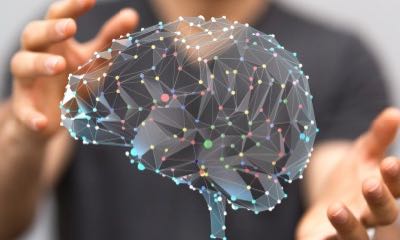41 Fascinating Facts About Your Amazing Brain

Your brain is a mystery only it can solve. Unraveling the riddle of how your body’s command center works—perception, the formation of thoughts, memory creation, and more—might seem like daunting, headache-inducing work.
But your brain is up to the task. Every second of the day it takes in so much information. Then it links disparate parts to make a whole thought, decision, memory, or picture of your world. Your brain is the ultimate processing unit, taking facts—from senses, chemical messages, or other stimuli—and spitting out a conclusion.
So, if you’re going to demystify your brain, it’s probably best to lay out the facts first. And your amazing brain will do the rest of the work putting the puzzle together.
Here are 41 facts about brain anatomy, perception, thoughts, memory, and healthy habits for your brain:
All About Your Brain Anatomy and Structure
- Your brain, if you’re an adult, is about three pounds (1.4 kilograms) of firm-jelly-textured human computing power. And it’s surprisingly fatty—about 60 percent of the brain is fat.
- All your thinking, deciding, and processing drains about 20 percent of the total energy, oxygen, and blood in your body. So much power and so many resources for about two percent of your total weight. And delivering all that blood, oxygen, and nutrients requires almost 100,000 miles of blood vessels to be packed into your skull.
- Your brain did a lot of growing in your first year of life—when it tripled in size. But life shrinks your brain. After you hit middle age, your brain decreases in physical size as time passes.
- A bigger brain doesn’t mean anything. Physical size hasn’t been found to have any significant correlation with higher intelligence. In general, research has only found brain size to be responsible for around 10 percent of intelligence variability.
- You do have a left and right brain. That’s because it’s divided into two almost symmetrical—but not identical—hemispheres connected by the corpus callosum (a nerve bundle).
- Your brain is kind of cross-wired. The left side controls muscles on your body’s right side. The right side of your brain is responsible for pulling the strings on the muscles of your left side. It sounds confusing, but your brain has it figured out.
- The whole brain chips in for creativity and other mental tasks. So, artistic people aren’t really relying more on their right brain. Analytical people aren’t more left brained. Slight cognitive differences have been found in the hemispheres, but it’s not accurate to call yourself right brained, unless the left side has been removed.
- There are three major parts of the brain: the cerebrum, cerebellum, and brain stem.
- The cerebrum is the brain’s biggest part, accounting for 85 percent of its weight. It needs that size to handle a lot of survival tasks (movement, senses, temperature, and judgment). And the cerebrum also tackles higher-order operations—problem solving, reasoning, emotions, and learning.
- You can thank (or blame) your cerebellum for your posture and balance. And your brain stem handles a lot of processes you do without thinking. But they keep you alive—breathing and keeping your heart beating. The brain stem also shuttles information from your sensory organs, helps you swallow, and cough.
- Science also splits the brain up into four lobes: the frontal, parietal, occipital, and temporal lobes. Each lobe handles specific tasks. The frontal lobe tackles thinking tasks, as well as movement and short-term memory. Sensory information on touch and taste is processed in your parietal lobe. Your occipital lobe is all about processing and storing the information your eyes take in. The temporal lobe works on memory storage, smell, taste, and sound.
- That’s a lot information already. Does your head hurt? If it does, you can bet it isn’t actually your brain. It interprets signals from around the body, but feels no pain itself. You can even trace brain freeze to the blood vessels in your throat constricting from cold, not your actual brain.
How Your Brain Works and Communicates
- You use more than 10 percent of your brain. In fact, your whole brain is working most of the time. It has to. That’s the only way your complex body runs smoothly and you stay safe.
- The human brain is far better than the best computer ever created. It can handle a lot of information every second, and process it all faster than a computer. And that means A LOT of information—up to 10 to the 16th power every second.
- All that processing means information travels fast around your brain. Although the speed of information varies, it’s estimated info can ping around the brain at about 250 miles per hour (402 kilometers per hour).
- What makes all this speed and computing possible? Neurons. There are about one hundred billion—a one followed by 11 zeroes—of these nerve cells in your brain. They’re able to communicate with other neurons via chemical or electrical signals.
- Neurons are cells, but they have unique properties that set them apart from your other cells. And these physical differences help them do their job. Neurons have special branches on one end called dendrites and axons on the other. The dendrites receive information, while the axon on the other end sends the information to the next neuron.
- Synapses are the spaces between neurons where they come very, very close to touching in order to relay information. When you have a new thought or remember something, new synaptic connections are created.
- The chemical messengers of the brain are called neurotransmitters. That makes sense because your body makes these chemicals to literally transmit messages between neurons. You’ve probably heard of a few neurotransmitters like adrenaline, dopamine, and serotonin.
- Your brain isn’t the same as anyone else’s. Your experiences—including what happens to you and what you learn—wire your brain in a unique way. And that wiring continues to develop as you learn and experience more.
- The mechanics of the working brain are amazing. It allows you to do so many higher-order tasks (processes not tied to survival). But multitasking is still impossible. When someone says they’re multitasking, they’re alternating between higher-order tasks. They may do the switching quickly, but the tasks aren’t happening simultaneously.
- Your brain gets bored easily. Research has found that every 10 minutes you need something that sparks you emotionally to hit the reset button on your attention. If that 10-minute number sounds long, it’s because the human attention span (how long you can pay attention to a single thing) continues to shrink. It’s down to an average of eight seconds—down four seconds in just 15 years.
- Even if your brain gets bored, it never loses focus on survival. It’s your body’s command center, so survival is always the first priority. That means your brain constantly makes decisions about safety and solves problems to keep you safe. In nature, those fight-or-flight decisions may actually be lifesaving. But in modern life, the constant barrage of non-dangerous, but stressful situations trick your brain into survival mode. This can create unhealthy levels of stress.
- Your whole brain doesn’t sleep—not fully, at least. And your dreams are proof. Science doesn’t even know everything about dreams. But they’re thought to be a function of imagination, psychology, and neurology mixing together.
Shaping Perception and Thought in the Brain
- In a dream, you might perceive a fantastical environment or adventure. It’s your brain’s job to set your perception. It uses sensory data to paint a complete picture of your world. Perception isn’t as simple as collating sensory data, though. It’s more complex.
- Those brain-sensory complexities can create conditions like synesthesia. This is when your senses converge to layer a perception on one sense. A common example is when people see colors when they hear music.
- The reason perception can vary has everything to do with the brain’s interaction with sensory information. Take hearing as an example. Your ears collect sound waves. But your experience of hearing and listening is shaped in the brain. So, that’s why two people can have the same sound waves enter their ears, but think they hear something different. Like with the Laurel vs. Yanny viral sensation of 2018, if there’s any ambiguity, your brain uses your experiences to flesh out the phrasing to give you a perception of the sound. And that can be different for people.
- Brain researchers can watch you think. That’s because physically, thoughts show up in imaging as many neurons firing. There are still a lot of mysteries about how thoughts are formed and what processes are responsible, though. At a basic level, your brain connects different information to form a new mixture called a thought.
Making Memories
- You should be impressed by the brain’s ability to perceive the world and generate thoughts. But memory is just as amazing. It’s estimated your brain can store 2,500,000 gigabytes of information.
- You have two basic types of memory: short-term and—you probably guessed it—long-term memory.
- There’s a reason your short-term memory is also referred to as working memory. For the most part, it operates by allowing you to remember information long enough for you to use it. That’s why you can remember a phone number to dial it, but might forget it right after the call ends.
- Dredging up memories isn’t exactly like pulling a file from a folder. Your brain has to recreate and reimagine that memory. And it’s not a perfect copy of the original.
- The ability to look up any of the information in the world is great for everything except your memory. Your brain isn’t lazy, per se. But it’s very busy and prioritizes tasks that absolutely need to be done. So, if it knows you can look something up again, your brain may not store that tidbit of information.
- Pictures are powerful tools for memory. Studies have shown people retain 65 percent more information when images are involved.
- Science has a name for wisdom—all the situations and information you’ve experienced and stored. Scientists call it cognitive template.
- Want to help yourself remember information? Try these tips. Repetition helps. Repeating information really works. So does adding more context. That means stringing a few bits of information about a person with their name to help you remember it better. These associations strengthen memory. You can also try to pour information into your brain at a slower rate. A flood of information just won’t sink in, as well.
Facts About Habits to Maintain That Insanely Awesome Brain
- Water plays a big role in brain health and computing power. That’s because your brain is about 75 percent H2O. So, stay hydrated to keep your brain cranking full-steam ahead.
- Sleep is important to being your best self. You’ve been sleep deprived before. Did you have a banner mental day after your four hours of shut eye? Doubtful. Sleep is when your brain rests (but, as you know now, doesn’t completely shut down). A lack of sleep impacts information processing, attention, memory, mood, and logic.
- Your brain gets sleepy. So, if you crave a nap about 3 p.m., that’s normal. It’s just your brain trying to rest. Keep that in mind when you’re designing your daily schedule.
- Just because your brain likes naps and wants plenty of sleep that doesn’t mean it wants you to be sedentary. Actually, the opposite. Regular exercise supports brain health and cognition as much as your waistline.
- Don’t stress. Your brain doesn’t like it. Stress is bad for your overall health. But it can really cause problems with learning and many important aspects of cognition. Your brain can deal with short-term stresses. It was built to help you survive, after all. But hours of steeping in a stressful situation is bad for your brain. So, work on coping mechanisms that take you out of your long-suffering stressful state.
From Facts to Action
Now that you know a little bit more about your body’s command center, take care of it. You don’t need the knowledge of a neuroscientist to appreciate and pamper for your brain.
Do the things it likes—sleeping, learning, exercising—and avoid stress and behaviors that might harm it. And don’t forget to feed your brain the nutrients it needs by eating a diet full of fruits, vegetables, and good fats. Your brain is hungry for healthy foods, and knowledge. Continue to feed it both so it can stay happy and healthy.
References
https://www.healthline.com/health/fun-facts-about-the-brain#1
https://sciencefirst.com/10-interesting-facts-about-the-human-brain/
https://www.piedmont.org/living-better/10-fun-facts-about-your-brain
http://mentalfloss.com/article/591344/wild-animals-in-salad-science-research
https://theweek.com/articles/460769/12-things-know-about-how-brain-works
https://www.scientificamerican.com/article/does-brain-size-matter1/
https://www.hopkinsmedicine.org/health/conditions-and-diseases/anatomy-of-the-brain
https://www.mayoclinic.org/brain/sls-20077047?s=3
https://www.ncbi.nlm.nih.gov/pmc/articles/PMC3860493/
https://news.nationalgeographic.com/2018/05/yanny-laurel-hear-sound-audio-explained-science-spd/
https://www.scientificamerican.com/article/mind-aglow-scientists-watch-thoughts-form-in-the-brain/
https://www.psychologytoday.com/us/blog/consciousness-and-the-brain/201202/what-is-thought

















